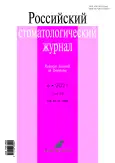Sensitivity of parodontopatogens to the cell juice of Siberian fir (microbiological investigation)
- Authors: Romanov A.S.1, Ragulin A.V.2, Olesov E.E.2, Tsarev V.N.1, Olesova V.N.1
-
Affiliations:
- Medical and Biological University named after A.I. Burnazyan
- Academy of Postgraduate Education
- Issue: Vol 25, No 6 (2021)
- Pages: 505-510
- Section: Experimental and Theoretical Investigation
- URL: https://journals.rcsi.science/1728-2802/article/view/108224
- DOI: https://doi.org/10.17816/1728-2802-2021-25-6-505-510
- ID: 108224
Cite item
Abstract
BACKGROUND: Search for new effective means of preventing inflammatory complications in the state of peri-implant tissues is relevant; in particular, products from coniferous greens produced by the Solagift company (Tomsk) are of interest. The “bioeffective cell juice of the Siberian fir,” the 100% carbon dioxide extract of Siberian fir (water fraction), stands out among them. Fir cell juice is recommended for enhancing immunity, preventing inflammatory diseases of the upper respiratory tract, and treating several pathological conditions. Fir juice contains vitamin C, carotene, polyphenolic compounds, flavonoids, iron, magnesium, copper, manganese, zinc, and maltol–iron chelate complex (a natural antioxidant).
AIM: This microbiological study aimed to examine the sensitivity of periodontal pathogens to “bioeffective cell juice of Siberian fir” of various concentrations.
MATERIAL AND METHODS: A number of periodontal pathogens were cultivated in the presence of “bioeffective Siberian fir cell juice” in the following proportions: 1:5, 1:10, and 1:15. Incubation for up to 3 days was conducted in a reverse-spinner RTS-1 bioreactor (BioSan, Latvia) with automatic analysis of the optical density (OD) of the culture at a wavelength (λ) of 850 nm. OD was measured in McFarland units (mcf). The assessment of culture growth control was based on the analysis of the growth phases of periodontal pathogens: adaptive (lag phase), exponential (log phase), stationary, and withering away. The following clinical isolates of microorganisms were used: Streptococcus constellatus, Staphylococcus aureus, Fusobacterium nucleatum, and Aggregatibacter actinomycetemcomitans.
RESULTS: The microbiological study of the sensitivity of periodontal pathogens (such as S. constellatus, S. aureus, F. nucleatum, and A. actinomycetemcomitans) to “bioeffective cell juice of Siberian fir” showed a growth slowdown of microorganisms in the presence of fir juice and inhibition of the growth of a culture of periodontal pathogens when co-cultivated with fir juice. A significant decrease in the OD of cultures of all studied periodontal pathogens was observed at a fir juice concentration of 1:10 and 1: 5. At these concentrations, there was no growth of S. aureus culture, and the degree of decrease in the average OD of other periodontal pathogens reached 27.1% (A. actinomycetemcomitans), 31.8% (F. nucleatum), and 33.6% (S. constellatus).
Full Text
##article.viewOnOriginalSite##About the authors
Alexey S. Romanov
Medical and Biological University named after A.I. Burnazyan
Author for correspondence.
Email: docromanoff@yandex.ru
ORCID iD: 0000-0002-4414-0270
postgraduate
Russian Federation, 15, Gamaley str., Moscow, 123098Arseniy V. Ragulin
Academy of Postgraduate Education
Email: senya12_95@mail.ru
Russian Federation, Moscow
Egor E. Olesov
Academy of Postgraduate Education
Email: olesov_georgiy@mail.ru
ORCID iD: 0000-0001-9165-2554
SPIN-code: 8924-3520
MD, Dr. Sci. (Med.), associate professor
Russian Federation, MoscowViktor N. Tsarev
Medical and Biological University named after A.I. Burnazyan
Email: nikola777@rambler.ru
ORCID iD: 0000-0002-3311-0367
SPIN-code: 8180-4941
MD, Dr. Sci. (Med.), professor
Russian Federation, MoscowValentina N. Olesova
Medical and Biological University named after A.I. Burnazyan
Email: olesova@implantat.ru
ORCID iD: 0000-0002-3461-9317
SPIN-code: 6851-5618
MD, Dr. Sci. (Med.), professor
Russian Federation, MoscowReferences
- Olesova VN, Bronstein DA, Stepanov AF, et al. The incidence of inflammatory complications in peri-implant tissues according to long-term clinical analysis. Dentist. 2017;(1):58–62. (In Russ).
- Kulakov AA. Dental implantation: national guidelines. Moscow: GEOTAR-Media; 2018. (In Russ).
- Nikitin VV, Olesova VN, Pashkova GS, et al. Prevention of peri-implantitis using a bacteriophage-based agent. Russian Bulletin of Dental Implantology. 2017;(2):55–59. (In Russ).
- Revazova ZE, editor. Periodontics. National leadership. 2nd edition. Moscow. 2018; 752s. (In Russ).
- Tsarev VN, Panin AM, Chuvilkin VI, et al. Comprehensive assessment of the content of periodontal pathogenic bacteria and cytokines in peri-implantitis using PCR and enzyme-linked immunosorbent assay. Russian Bulletin of Dental Implantology. 2017;(3–4):86–90. (In Russ).
- Gvetadze RS, Dmitrieva NA, Voronin AN. Comparative analysis of the degree of colonization of microorganisms on the surface of individual gingiva formers. Institute of Dentistry. 2019;(3):30–31. (In Russ).
- Ushakov RV, Tsarev VN. Antimicrobial therapy in dentistry. Principles and algorithms. Moscow: RMANPO; 2019. (In Russ).
- Tsarev VN, Nikolaeva EN, Ippolitov EV. Periodontal pathogenic bacteria are the main factor in the onset and development of periodontitis. Journal of Microbiology, Epidemiology and Immunobiology. 2017;(5):101–112. (In Russ).
- Solagift [Internet]. Company Solagift company [cited 06 Jan 2022]. Available from: www.solagift.ru.
- Tsarev VN, Atrushkevich VG, Ippolitov EV, Podporin MS. Comparative analysis of the antimicrobial activity of periodontal antiseptics using an automated system for monitoring the growth of microorganisms in real time. Periodontics. 2017;(1):4–10. (In Russ).
- Morozov DI, Volkov AG, Dikopova NZ, et al. Determination of the minimum inhibitory concentration to metronidazole of representatives of obligate and facultative anaerobic microflora of periodontal pockets. Russian dental journal. 2021;1(25):53–57. (In Russ).
Supplementary files








